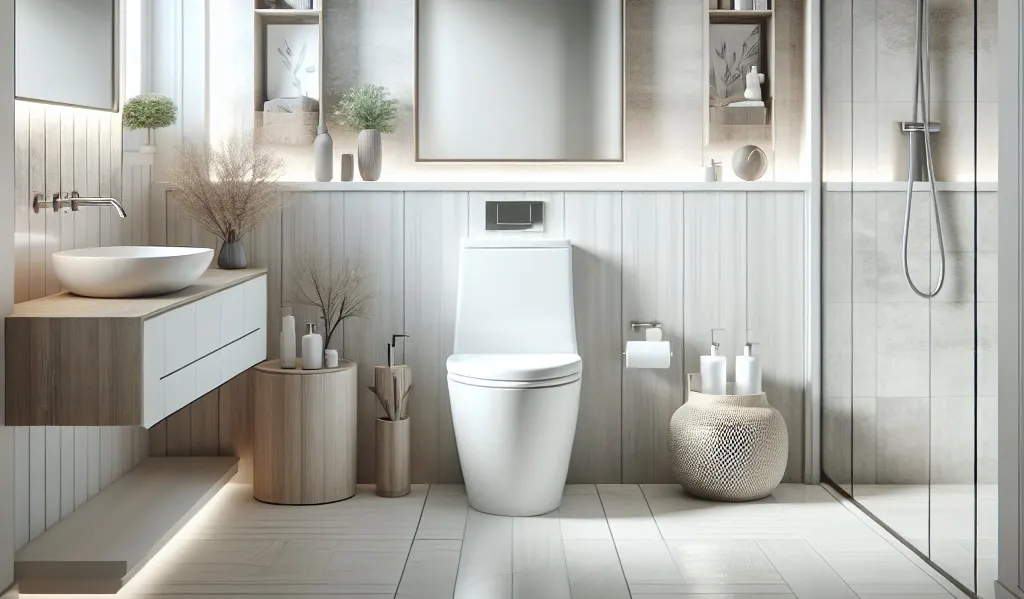Choosing Between One-Piece and Two-Piece Toilets
You’re remodeling your bathroom and it’s time to pick a new toilet, but you’re stuck on a common dilemma: one-piece vs. two-piece toilet?
Both get the job done, but understanding their differences can help you make the best choice for your needs and budget.
This blog post breaks down the pros and cons of each type, covering cost, installation, cleaning, durability, aesthetics, and more!
So, which type of toilet is better?
The best toilet for you depends on your priorities and bathroom setup.
- One-piece toilets offer a sleek look and easier cleaning but come with a higher price tag.
- Two-piece toilets are more budget-friendly and offer more flexibility in terms of style and rough-in measurements but can be more prone to leaks.
Still have questions? Keep reading!
- What’s the Difference Between a One-Piece and a Two-Piece Toilet?
- Factors to Consider When Choosing a Toilet
- Features and Options
- Emerging Trends: Smart Toilets
- Making the Decision: Which Toilet is Right for You?
- One-Piece vs. Two-Piece Toilets: FAQ
Let’s flush out the details and help you make the right decision!
- Choosing Between One-Piece and Two-Piece Toilets
- I. Understanding the Basics: One-Piece vs. Two-Piece Toilets
- II. Factors to Consider When Choosing a Toilet
- III: Features and Options
- IV. Emerging Trends: Smart Toilets
- V. Making the Decision: Which Toilet is Right for You?
- One-Piece vs. Two-Piece Toilets: FAQ
- What is the main difference between a one-piece and a two-piece toilet?
- Are one-piece toilets better than two-piece toilets?
- Which type of toilet is easier to install?
- Which toilet is easier to clean?
- Are one-piece toilets more durable?
- What are the cost differences between the two types of toilets?
- Do both types of toilets offer water-saving features?
- Can a one-piece toilet replace a two-piece toilet?
- What are the advantages and disadvantages of one-piece vs. two-piece toilets in terms of installation, cleaning, and cost?
- Installation
- Cleaning
- Cost
- Summary Table
- Why is a one-piece toilet often considered more durable than a two-piece toilet?
- How Toilet Design Impacts Ease of Cleaning
- Conclusion: Making the Right Choice for Your Bathroom
THIS POST MAY CONTAIN AFFILIATE LINKS. As an Amazon Associate, I earn from qualifying purchases. PLEASE READ MY DISCLOSURE FOR MORE INFO.
I. Understanding the Basics: One-Piece vs. Two-Piece Toilets
This section provides a fundamental overview of one-piece and two-piece toilets, highlighting their defining characteristics and key features.
What is a One-Piece Toilet?
A one-piece toilet, as its name suggests, is a single, seamless unit where the tank and bowl are molded together as one piece of porcelain. This integrated design gives it a sleek and modern appearance, often favored in contemporary bathroom settings.
Key Features of a One-Piece Toilet:
- Seamless Design: The tank and bowl are fused, creating a smooth, continuous surface.
- Modern Aesthetic: The integrated design gives it a sleek, minimalist look.
- Heavier Weight: Due to the single-mold construction, one-piece toilets are generally heavier than their two-piece counterparts.
What is a Two-Piece Toilet?
A two-piece toilet is the more traditional style, featuring a separate tank and bowl that are connected using bolts. This design allows for easier transportation and maneuvering during installation.
Key Features of a Two-Piece Toilet:
- Separate Tank and Bowl: The tank and bowl are distinct units, bolted together during installation.
- Traditional Design: The two-piece construction is the classic toilet style.
- Lighter Weight: The separate components make it easier to transport and handle.
This section has laid the groundwork by explaining the basic differences between one-piece and two-piece toilets. The following sections will explore the factors you should consider when deciding which type is right for your bathroom.


Source: Amazon.com
Comparison Table: One-Piece vs. Two-Piece Toilets
| Feature | One-Piece Toilet | Two-Piece Toilet |
|---|---|---|
| Design | Integrated tank and bowl, seamless design | Separate tank and bowl, connected with bolts |
| Aesthetics | Sleek, modern appearance | More traditional look, can be less stylish |
| Cleaning | Easier to clean due to seamless design, fewer crevices for dirt and grime | Harder to clean due to gap between tank and bowl, prone to dirt accumulation |
| Durability | More durable, less prone to leaks and cracking due to single-piece construction | More susceptible to leaks and cracking at the connection between the tank and bowl |
| Installation | Faster installation once in place, but heavier and harder to maneuver | Easier to maneuver due to separate pieces, but requires assembly |
| Rough-in Options | Fewer rough-in options, may be limited in placement | More rough-in options, provides flexibility in placement |
| Cost | More expensive, typically ranging from $500 to $1,100 | Less expensive, typically ranging from $250 to $700 |
| Repairs | Can be more difficult to repair; damage may require replacing the whole unit | Easier to repair, often only the damaged part needs replacement |
| Weight | Heavier, may require two people to move | Lighter, easier to handle due to separate pieces |
| Shipping | More difficult and expensive to ship due to weight and size | Easier and less expensive to ship due to separate pieces |
This table summarizes the key differences between one-piece and two-piece toilets, making it easier for you to compare and contrast their features. Remember to consider your individual needs and priorities when making your decision.
THIS POST MAY CONTAIN AFFILIATE LINKS. As an Amazon Associate, I earn from qualifying purchases. PLEASE READ MY DISCLOSURE FOR MORE INFO.
Top 3 Amazon Best Seller One-Piece Toilets
II. Factors to Consider When Choosing a Toilet
This section explores the key factors you should consider when choosing between a one-piece and two-piece toilet, empowering you to make an informed decision that aligns with your needs, preferences, and budget.
Cost Considerations
One-piece toilets are typically more expensive than two-piece toilets. The higher cost of one-piece toilets is attributed to their advanced assembly process and the fact that they are less common. On average, one-piece toilets range from $500 to $1,100, while two-piece toilets are available for $250 to $700. The price difference is also influenced by factors like brand, features, and design. If you are on a tight budget, a two-piece toilet is generally the more affordable option. However, if budget allows, the added benefits of a one-piece toilet might be worth the investment.
Installation Process
Two-piece toilets can be easier to maneuver during installation because the tank and bowl are separate, making them lighter to carry. You can carry each piece to the bathroom separately, making it easier to navigate through the home. However, the actual installation of a two-piece toilet can be more complex as it involves assembling the tank and bowl and ensuring a proper seal to prevent leaks. A one-piece toilet is generally easier to install once it is in position because it’s pre-assembled, requiring fewer steps. However, the heavier weight of a one-piece toilet can make it more challenging to transport and position, requiring at least two people.
Cleaning and Maintenance
One-piece toilets are generally considered easier to clean and maintain due to their seamless design. The absence of a gap between the tank and bowl eliminates crevices where dirt and grime can accumulate, making cleaning simpler. Two-piece toilets, with the gap between the tank and bowl, require more attention to keep clean as contaminants can build up in the space.
Durability and Longevity
One-piece toilets are considered more durable due to their single, fused design. The integrated construction makes them less susceptible to leaks, cracks, and corrosion. Two-piece toilets, with their separate components joined by bolts, are more prone to leaks and potential issues with the tank-to-bowl connections over time. However, with proper care, both types of toilets can last for many years.
Aesthetic Appeal
One-piece toilets are favored for their sleek, modern aesthetic. The seamless design provides a clean, contemporary look that complements modern bathroom styles. Two-piece toilets offer a more traditional look, which might be preferred in certain bathroom designs. Both types are available in a variety of styles and colors, offering options to suit different preferences.
Moen MotionSense Faucet Not Working (How To Fix)
III: Features and Options
This section explores the array of features and options available in both one-piece and two-piece toilets, highlighting innovations that enhance water efficiency, comfort, and overall functionality.
Both one-piece and two-piece toilets are available with a range of features that enhance comfort, water efficiency, and hygiene. Common features include:
- Water-Saving Options: Both types offer low-flow and dual-flush options to reduce water consumption.
- Comfort Features: Features like heated seats, bidet attachments, and touchless flushing are available for both types.
- Style Variations: Both one-piece and two-piece toilets come in a variety of styles, colors, and sizes to match different bathroom aesthetics and space requirements.
Water-Saving Technologies
Both one-piece and two-piece toilets are available in a variety of styles that incorporate key water-saving features, such as low-flow and dual-flush options. Low-flow toilets are engineered to consume less water per flush compared to standard toilets, and this feature is prevalent in both toilet types. Similarly, dual-flush functionality allows for a low-flow flush for liquids and a more powerful flush for solid waste, promoting water conservation. For those with existing toilets, a toilet tank displacement device can be a cost-effective retrofit solution to reduce water usage.
Enhancing Comfort and Convenience
Beyond water-saving features, modern toilets offer additional features that can elevate comfort and convenience. These include:
- Bidet attachments
- Heated seats
- Motion-activated seats
- Touchless flushing
- Air dryers
- And built-in deodorizers.
Some features, like bidet attachments or heated seats, can be added to existing toilets. Other features, such as dual flush or low-flow mechanisms, are typically built-in.
The availability and price of these extra features may vary depending on the specific make and model of the toilet, regardless of whether it’s a one-piece or two-piece design.
Question: How do the different flushing mechanisms mentioned in the sources (flappers, towers, dual flush) work, and how do they impact water efficiency?
**Answer: **Flappers and towers are the traditional mechanisms used in toilets to regulate the flow of water from the tank into the bowl. Flappers are rubber stoppers that open and close to release water, while towers are plastic columns that rise and fall to control the flow of water. Both mechanisms can contribute to water efficiency if properly maintained and adjusted.
Dual flush toilets, on the other hand, offer two separate flushing options – a low-flow option for liquid waste and a full-flush option for solid waste. This allows for more control over water usage as less water is needed for liquid waste compared to solid waste. This feature typically leads to higher overall water efficiency in dual-flush toilets compared to traditional ones.
Change Your Bathroom Sink Faucet The Easy Way
IV. Emerging Trends: Smart Toilets
Smart toilets represent a growing trend in bathroom technology, offering advanced features such as automatic flushing, self-cleaning functions, and personalized settings. While currently available, they might not be as common as traditional toilets.
Question: Beyond cost and aesthetics, what are the practical differences in performance between one-piece and two-piece toilets?
Answer: In terms of performance, both one-piece and two-piece toilets can function similarly. However, due to the seamless design and heavy weight of one-piece toilets, they may have a slightly more powerful flush than two-piece toilets. Additionally, as mentioned earlier, one-piece toilets are generally easier to clean and maintain, which can contribute to better overall performance in terms of hygiene.
Features of Smart Toilets
smart toilets typically offer features such as:
- Automatic Flushing: Sensors detect when the user has finished and automatically initiate flushing, promoting hygiene and convenience.
- Self-Cleaning Functions: Some smart toilets incorporate built-in cleaning mechanisms, such as UV sanitation or water jets, to help maintain cleanliness and reduce the need for manual cleaning.
- Heated Seats: Adjustable seat warmers provide personalized comfort, particularly during colder months.
- Bidet Functionality: Integrated bidet features offer a more hygienic and refreshing alternative to traditional toilet paper, often with adjustable water pressure and temperature settings.
- Nightlights: Built-in nightlights illuminate the bowl for easier use during nighttime visits, enhancing safety and convenience.
- Personalized Settings: Some smart toilets allow users to customize settings, such as water temperature, seat height, and flush intensity, to personalize their bathroom experience.
- Water Efficiency: Smart toilets often incorporate water-saving technologies, such as dual-flush options, to minimize water consumption.
Considerations
- Cost: Smart toilets generally have a higher price tag compared to traditional one-piece or two-piece toilets due to their advanced technology and features.
- Technology Reliance: The incorporation of technology into toilets introduces potential reliance on electronic components, which may be susceptible to malfunctions or require technical support.
- Privacy Concerns: Smart toilets with advanced features, such as personalized settings or health monitoring capabilities might raise privacy concerns for some users regarding data collection and usage.
It’s important to weigh these considerations carefully when deciding if a smart toilet is the right choice for your bathroom and lifestyle.
V. Making the Decision: Which Toilet is Right for You?
After exploring the features, options, and emerging trends in toilets, it’s time to decide which type best suits your needs and preferences. Here’s a recap of the pros and cons of one-piece and two-piece toilets:
One-Piece Toilets:
Pros:
- Sleek, modern aesthetic
- Easier to clean and maintain
- More durable, less prone to leaks
- Faster installation (once in position)
- Often available in comfort height
Cons:
- More expensive
- Heavier, more difficult to maneuver during installation
- Fewer rough-in options
- More difficult to ship
Two-Piece Toilets:
Pros:
- Less expensive
- Easier to maneuver during installation (due to separate components)
- More options for height, style, and rough-in
- Easier to ship
- Potentially easier to repair (only damaged part needs replacing)
Cons:
- Less stylish, more traditional look
- Harder to clean
- More prone to leaks and breakage
- More time-consuming installation (assembly required)
Targeted Recommendations:
- Small Bathrooms: A one-piece toilet can be a better choice for compact spaces due to its integrated design, which often takes up less space than a two-piece toilet.
- Budget-Conscious: If you’re on a tight budget, a two-piece toilet is the more affordable option, offering a wider range of price points.
- DIY Enthusiasts: The separate components of a two-piece toilet can make repairs easier, as you may only need to replace the damaged part instead of the entire unit.
- Aesthetics: For a sleek, modern look that complements contemporary bathroom designs, a one-piece toilet is often preferred.
Toilet Decision Flowchart
This flowchart helps you decide between a one-piece and a two-piece toilet, based on information from the sources:
- Budget: Do you have a limited budget?
- Yes: Two-piece toilets are generally more affordable. → Two-Piece Toilet
- No: Consider other factors. → Next Question
- Bathroom Size: Is your bathroom small?
- Yes: One-piece toilets can be more compact. → One-Piece Toilet
- No: Consider other factors. → Next Question
- DIY Skills and Repair Preferences: Are you comfortable handling repairs yourself?
- Yes: Two-piece toilets might be easier to repair, as individual parts can be replaced. → Two-Piece Toilet
- No: Consider other factors. → Next Question
- Aesthetic Preference: Do you prefer a sleek, modern look?
- Yes: One-piece toilets offer a more contemporary and streamlined aesthetic. → One-Piece Toilet
- No: Two-piece toilets offer a more traditional look with potential for customization. → Two-Piece Toilet
Additional Factors to Consider:
- Ease of Cleaning: One-piece toilets are easier to clean due to their seamless design.
- Durability: One-piece toilets tend to be more durable and less prone to leaks.
- Installation: While a one-piece toilet is quicker to install once in place, its weight can make maneuvering challenging. Two-piece toilets are easier to move but require assembly.
- Rough-in Options: Two-piece toilets offer greater flexibility in terms of rough-in sizes.
Remember to consult with a plumbing professional for specific advice tailored to your bathroom and needs.
By considering these factors and perhaps using a visual aid like a flowchart, you can confidently choose the toilet that best meets your specific needs and preferences.
One-Piece vs. Two-Piece Toilets: FAQ
What is the main difference between a one-piece and a two-piece toilet?
The primary difference lies in their construction. A one-piece toilet features a seamless design where the tank and bowl are fused, creating a single unit. In contrast, a two-piece toilet has a separate tank and bowl bolted together. This structural variation leads to differences in appearance, installation, cleaning, and durability.
Are one-piece toilets better than two-piece toilets?
There is no definitive “better” option, as the best choice depends on individual needs and preferences.
One-piece toilets offer a sleek, modern aesthetic, easier cleaning due to fewer crevices, and increased durability with less risk of leaks. However, they are heavier, more expensive, and may be challenging to install in tight spaces.
Two-piece toilets are budget-friendly, easier to maneuver during installation, and offer more flexibility in size and style combinations. However, they have more crevices that can trap dirt, are more prone to leaks, and may not be as visually appealing as one-piece models.
Which type of toilet is easier to install?
While maneuvering a two-piece toilet might be easier due to its separate components, the overall installation process is generally faster and more straightforward for a one-piece toilet. This is because the one-piece arrives pre-assembled, eliminating the need to bolt the tank and bowl together.
Which toilet is easier to clean?
One-piece toilets are undeniably easier to clean. Their seamless design eliminates the gap between the tank and bowl, reducing the accumulation of dirt and grime. This makes cleaning quicker and more hygienic.
Are one-piece toilets more durable?
Yes, one-piece toilets tend to be more durable. Their single-piece construction minimizes the risk of leaks and cracks that can occur at the connection point in two-piece models.
What are the cost differences between the two types of toilets?
One-piece toilets are generally more expensive, ranging from $500 to $1,100. Two-piece toilets are more budget-friendly, costing between $250 and $700.
Do both types of toilets offer water-saving features?
Yes, both one-piece and two-piece toilets are available with water-saving features such as low-flow options and dual flush systems. These features help conserve water and reduce your environmental impact.
Question: What are the environmental impacts of toilet manufacturing and disposal?
Answer: Toilet manufacturing and disposal can have both positive and negative environmental impacts. On one hand, modern toilets are designed to use less water, which can help conserve this valuable resource. Additionally, some manufacturers use sustainable materials in their production processes.
However, the production of toilets also requires energy and resources, contributing to carbon emissions and depletion of natural resources. The disposal of old toilets can also be problematic if they end up in landfills, as they may release harmful chemicals into the environment over time.
To minimize these impacts, it is important to choose a toilet from a reputable manufacturer that uses sustainable practices and materials whenever possible. It is also recommended to properly dispose of old toilets by recycling or donating them instead
Can a one-piece toilet replace a two-piece toilet?
Yes, a one-piece toilet can replace a two-piece toilet as long as the new toilet’s dimensions and rough-in measurement are compatible with your bathroom space. Be sure to measure carefully before purchasing.
What are the advantages and disadvantages of one-piece vs. two-piece toilets in terms of installation, cleaning, and cost?
Here is a comprehensive look at the advantages and disadvantages of one-piece vs. two-piece toilets in terms of installation, cleaning, and cost, based on the provided sources:
Installation
- One-piece toilets are heavier and bulkier, making them more difficult to maneuver and install. You will likely need at least two people to install a one-piece toilet.
- Two-piece toilets can be separated into two pieces (the tank and the bowl), which makes them easier to carry and install. However, you will need to assemble the two pieces on-site.
- Once the toilet is in place, a one-piece toilet is easier to install because it is pre-assembled.
- Installing a two-piece toilet can be more difficult because you need to ensure that there are no leaks between the two pieces and that the tank is properly bolted to the bowl.
Cleaning
- One-piece toilets are easier to clean because they have a smooth, seamless design. There are no crevices between the tank and the bowl where dirt and grime can build up.
- Two-piece toilets have a gap between the tank and the bowl, which can be difficult to clean.
Cost
- One-piece toilets are more expensive than two-piece toilets. On average, one-piece toilets cost between $500 to $1,100, while two-piece toilets cost between $250 to $700.
- The higher cost of one-piece toilets is due to several factors, including their more complex manufacturing process, heavier weight (which increases shipping costs), and lower demand.
Summary Table
| Feature | One-Piece Toilet | Two-Piece Toilet |
|---|---|---|
| Installation | More difficult to maneuver, easier to connect | Easier to maneuver, more difficult to connect |
| Cleaning | Easier to clean | More difficult to clean |
| Cost | More expensive (average $500 to $1,100) | Less expensive (average $250 to $700) |
| Other | Sleeker and more modern appearance, more durable, more compact, may be easier to repair | More traditional appearance, less durable, less compact, may be more difficult to repair (but individual parts are easier to replace) |
Ultimately, the best type of toilet for you depends on your budget, your DIY skill level, and your personal preferences. If you are looking for a toilet that is easy to clean and has a sleek, modern appearance, then a one-piece toilet may be a good option for you. However, if you are on a budget or prefer a more traditional look, then a two-piece toilet may be a better choice.
Why is a one-piece toilet often considered more durable than a two-piece toilet?
Here is an explanation of why one-piece toilets are often considered more durable than two-piece toilets:
- One-piece toilets are constructed as a single, fused unit, while two-piece toilets have a separate tank and bowl that are connected with bolts.
- This difference in design and installation makes two-piece toilets more susceptible to leaks, cracking, and corrosion.
- Dirt, grime, and other contaminants can get into the gap between the toilet tank and toilet bowl, leading to the premature breakdown of the washers, gaskets, and bolts in two-piece toilets.
- The coupling that connects the tank and bowl in a two-piece toilet may crack over time, leading to potential separation and the need for replacement.
- In contrast, the molded design of a one-piece toilet means there is less chance of breakage between these components.
Note: While one-piece toilets are considered more durable overall, they may be more difficult to repair if the porcelain cracks. Replacing the entire unit may be necessary in this case.
How Toilet Design Impacts Ease of Cleaning
The design of a toilet, specifically whether it is a one-piece or a two-piece model, significantly affects its ease of cleaning. Here’s a breakdown:
One-Piece Toilets:
- Easier to Clean: One-piece toilets are generally easier to clean due to their seamless, integrated design. The absence of a gap between the tank and bowl eliminates a prime area where dirt, grime, and bacteria can accumulate. This makes wiping down the toilet a quicker and more straightforward task.
- Smooth Surfaces: The smooth, continuous porcelain surface of a one-piece toilet further contributes to ease of cleaning. There are fewer nooks and crannies for dirt to hide, reducing the need for scrubbing and detailed cleaning.
Two-Piece Toilets:
- Harder to Clean: Two-piece toilets present more challenges for cleaning because of the gap between the tank and bowl. This crevice is prone to collecting dirt and grime, which can be difficult to remove. Regular cleaning is required to prevent the buildup of contaminants in this space.
- Leak Potential: The bolts and gaskets connecting the tank and bowl in a two-piece toilet can also be susceptible to leaks and corrosion over time, potentially adding to cleaning difficulties.
Overall, the sleek and integrated design of one-piece toilets makes them significantly easier to clean and maintain compared to their two-piece counterparts. The absence of a gap between the tank and bowl eliminates a major cleaning challenge, making them a more hygienic and user-friendly option.
Conclusion: Making the Right Choice for Your Bathroom
This exploration of one-piece and two-piece toilets aimed to equip readers with the knowledge needed to select the ideal toilet for their bathroom and lifestyle. The decision ultimately hinges on individual needs, preferences, and the specific characteristics of the bathroom space.
One-Piece vs. Two-Piece: A Balanced View
Both one-piece and two-piece toilets effectively serve their primary function, but they cater to different priorities. One-piece toilets, with their sleek and integrated design, are favored for their modern aesthetic, ease of cleaning, and generally enhanced durability. They are often a suitable choice for smaller bathrooms where space is a premium. However, their higher price point, heavier weight, and potential installation challenges should be considered.
Two-piece toilets remain a popular choice due to their affordability, wider range of styles and sizes, and potential ease of repair. While they may not possess the same sleekness as one-piece models and might require more cleaning effort, their practicality and budget-friendliness make them a viable option for many homeowners.
The choice between a one-piece and a two-piece toilet is a matter of weighing these factors and aligning them with your personal preferences and the unique characteristics of your bathroom.

I’m J.S., I created and am the content manager at DIYHouseSkills.com. I do the research and write the articles that appear on this website. I’ve learned many household skills during my life and think it’s important to at least know the basics so that you can save yourself time and money… READ FULL BIO >







